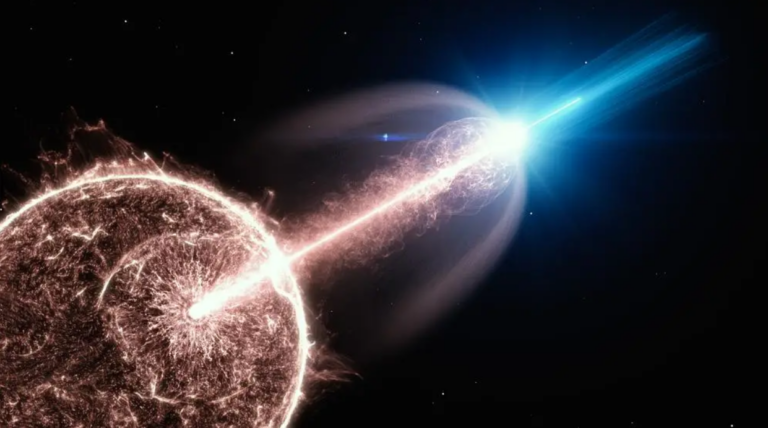Neutrinos are considered to be one of the most mysterious particles in the universe, second only to the enigmatic dark matter. They are produced in large quantities and play a vital role in weak nuclear force, nuclear fusion, and decay processes. Therefore, whenever a nuclear event occurs, neutrinos are inevitably present.
For example, in the core of the sun, a massive nuclear fusion reaction occurs, leading to the generation of a significant number of neutrinos. Research indicates that if you were to hold your thumb up to the sun, approximately 60 billion neutrinos would pass through your thumbnail every second.
Despite the large number of neutrinos passing through your body, they interact so rarely with matter that only about one neutrino will actually collide with your body throughout your entire lifetime.
Neutrinos have a mysterious and elusive nature. For many years, physicists believed these particles to be completely massless, traveling through the universe at the speed of light. However, accumulating evidence eventually led scientists to discover that neutrinos do have a tiny amount of mass.
The exact mass of neutrinos is still a topic of active scientific research. There are three types of neutrinos: the electron neutrino, the muon neutrino, and the tau neutrino. Each of these “flavors” participates in different nuclear reactions, and interestingly, all three types of neutrinos have the unique ability to change from one flavor to another during their journey. Therefore, even if one is able to observe a neutrino and determine its type, it only provides a small piece of the puzzle.
Whispers in Water
The mass of neutrinos remains unexplained within the Standard Model of particle physics, the leading theory governing fundamental interactions. Physicists aim to achieve two main goals: measuring the masses of the three neutrino flavors and understanding the origins of these masses. This requires conducting various experimental efforts.
Neutrino detectors typically operate on simple principles: either producing a large number of neutrinos in a lab setting or building extensive arrays to capture neutrinos from outer space.
These experiments have advanced significantly, growing in size with each new generation. For example, the Kamiokande experiment in Japan famously detected neutrinos from the supernova 1987A, using a massive tank with over 50,000 tons of water.
In recent years, the IceCube Neutrino Observatory in Antarctica has made further progress. With a cubic kilometer of ice at the South Pole and Eiffel-Tower-sized strings of receivers extending a kilometer into the ice, IceCube has discovered some of the most energetic neutrinos ever observed, hinting at their involvement in high-energy phenomena like blazars.
Why do both Kamiokande and IceCube rely on water? While various substances can detect neutrinos, pure water is the most effective. When a neutrino interacts with a water molecule, it emits a brief flash of light. The observatories have many photodetectors, and the purity of water allows for precise determination of the direction, angle, and intensity of these flashes. Impurities in the water would hinder accurate reconstruction of the flash’s origin.
As a result, scientists can reconstruct the original direction and energy of the incoming neutrino.
The Vast Pacific Neutrino Expanse
This method is effective in identifying regular neutrinos. Nevertheless, the most powerful neutrinos are extremely rare but fascinating, as they come from only the most significant events in the universe.
Unfortunately, despite ten years of observation by IceCube, only a few of these ultra-powerful neutrinos have been detected.
Therefore, a more comprehensive detection system is necessary. This idea forms the basis of the Pacific Ocean Neutrino Experiment (P-ONE), a new proposal presented in a paper on the arXiv preprint server in November. The goal is to convert a large area of the Pacific Ocean into a natural neutrino detector.
The plan is quite simple: Locate a suitable, isolated area in the Pacific Ocean, a task that is relatively easy. Then, install long strands of photodetectors, each at least a kilometer long, and submerge them to the ocean floor, ideally reaching depths of over a mile. Attach buoys to these strands to keep them upright in the water, resembling giant mechanical kelp.
Current configuration of P-ONE consists of seven clusters, each containing ten strings housing 20 optical elements. In total, there are 1,400 photodetectors spread across a vast area of the Pacific Ocean, spanning several miles. This setup allows for a significantly wider coverage compared to IceCube.
Once activated, the system requires patience as it waits for neutrinos to interact with the ocean water. These interactions produce faint flashes that are then detected by the apparatus.
However, the execution of this system is more complex than its conceptualization. The strands will constantly move and sway with the ocean’s currents. Additionally, the Pacific Ocean, despite its vastness, contains impurities such as salt, plankton, and marine debris. These factors will affect the behavior of light between the strands, posing challenges to obtaining precise measurements.
Therefore, continuous calibration is necessary to account for these variables and ensure accurate detection of neutrinos. The team leading the P-ONE project is actively addressing these challenges and has plans to construct a smaller-scale demonstration with two strands. This demonstration will serve as a proof of concept before embarking on full-scale neutrino hunting endeavors.
Do not forget to share your opinion with us to provide you with the best posts !




0 Comments